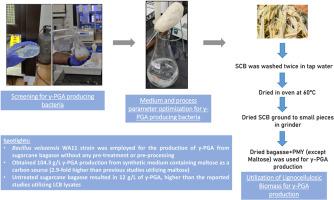淀粉样芽孢杆菌(Bacillus velezensis, WA11)直接从木质纤维素生物质底物中合成糖活性酶(CAZyme)和聚γ-谷氨酸(γ-PGA)的基因组挖掘
IF 3.8
Q2 BIOTECHNOLOGY & APPLIED MICROBIOLOGY
引用次数: 0
摘要
聚γ-谷氨酸(γ-PGA/PGA)是一种无毒、可生物降解的聚合物,具有更高的耐热性和保水性等多种特性,广泛应用于农业和食品加工、医疗和化妆品等领域。γ-PGA的工业生物基生产主要受到微生物菌株的潜力和底物成本的阻碍,这主要归因于碳源。本研究是一项概念验证研究,其中一种细菌分离物velezensis WA11菌株被用于从甘蔗甘蔗渣(木质纤维素生物质)中生产γ-PGA,而无需任何预处理或预处理。CAZyme注释鉴定了几个参与代谢复杂多糖的酶家族,包括纤维素、木聚糖和木质素。在以麦芽糖为碳源的优化合成培养基中,γ-PGA的产率为104.3 g/L,产率为1.09 g/L/h,比以麦芽糖为碳源的合成培养基提高了2.9倍。此外,用未经处理的甘蔗渣代替麦芽糖产生12 g/L的γ-PGA,高于大多数利用预处理的木质纤维素生物质(LCB)裂解物产生γ-PGA的研究。本研究表明,利用木质纤维素生物质生产γ-PGA无需预处理,为直接利用未经处理的木质纤维素生物质(LCB)通过潜在菌株生产昂贵的聚合物提供了一种无化学物质、可持续的途径。本文章由计算机程序翻译,如有差异,请以英文原文为准。

Genome mining of carbohydrate-active enzymes (CAZyme) and poly-γ-glutamic acid (γ-PGA) synthesis by Bacillus velezensis (WA11) directly from lignocellulosic biomass-based substrate
Poly-γ-glutamic acid (γ-PGA/PGA), a non-toxic and biodegradable polymer with additional diverse properties such as higher heat resistance and water retention, is widely implicated in myriad applications, including agricultural and food processing, medical treatments, and cosmetics. The industrial bio-based production of γ-PGA is primarily hindered by the potential of microbial strains and substrate costs, which are attributed primarily to the carbon sources. The present study is a proof-of-concept study, wherein a bacterial isolate, Bacillus velezensis WA11 strain, was employed for the production of γ-PGA from sugarcane bagasse (lignocellulosic biomass) without any pretreatment or pre-processing. The CAZyme annotation identified several enzyme families involved in metabolizing complex polysaccharides, including cellulose, xylan, and lignin. We obtained 104.3 g/L γ-PGA production with a productivity of 1.09 g/L/h in the optimized synthetic medium containing maltose as a carbon source, 2.9-fold higher than the earlier study using maltose as a carbon source. Further, substituting maltose with untreated sugarcane bagasse resulted in 12 g/L of γ-PGA, higher than most of the reported studies utilizing pretreated lignocellulosic biomass (LCB) lysates for producing γ-PGA. The present study demonstrates the production of γ-PGA using lignocellulosic biomass without pretreatment, providing a chemical-free, sustainable avenue for directly utilizing untreated lignocellulosic biomass (LCB) to produce expensive polymers by employing potential bacterial strains.
求助全文
通过发布文献求助,成功后即可免费获取论文全文。
去求助
来源期刊

Biocatalysis and agricultural biotechnology
Agricultural and Biological Sciences-Agronomy and Crop Science
CiteScore
7.70
自引率
2.50%
发文量
308
审稿时长
48 days
期刊介绍:
Biocatalysis and Agricultural Biotechnology is the official journal of the International Society of Biocatalysis and Agricultural Biotechnology (ISBAB). The journal publishes high quality articles especially in the science and technology of biocatalysis, bioprocesses, agricultural biotechnology, biomedical biotechnology, and, if appropriate, from other related areas of biotechnology. The journal will publish peer-reviewed basic and applied research papers, authoritative reviews, and feature articles. The scope of the journal encompasses the research, industrial, and commercial aspects of biotechnology, including the areas of: biocatalysis; bioprocesses; food and agriculture; genetic engineering; molecular biology; healthcare and pharmaceuticals; biofuels; genomics; nanotechnology; environment and biodiversity; and bioremediation.
 求助内容:
求助内容: 应助结果提醒方式:
应助结果提醒方式:


